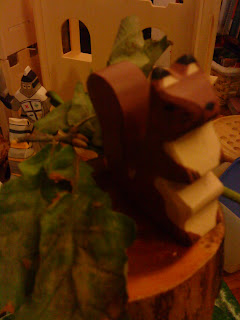Cinnamon and Ginger can be added to home made Playdough as a welcome alert to the senses. Glitter to could be added as long as you were sure that you did not have anyone who would try to eat it. ( I will list a great playdough recipe to add it to later in the day)
The texture of ice and snow that is etched on our own memories from childhood, always erases the sight and feel of the ice and snow that makes it difficult for us to get out of the farmyard at all. Although it makes life difficult for us now it still seems to bring joy and excitement. The children relish in the experience of getting out there in it -snugged up in scarves and coats and gloves.
So much can be achieved in basic terms of Self-esteem, and personal development for each child, as well as experiences for the EYFS.
- The planning and act of making a snow or ice shape and then seeing it dissolve as the weather changes is an experience that provides evidence for EYFS CD, PSED and PSRN.
- Measuring and monitoring Temperatures outside introduce routine and rhythm to our days, and also helps introduce negative numbers (PSRN and beyond) They also help the children note daily changes and give them a value.
- Comparison to an online temperature measurement system like this one from the Antarctic gives us a real grasp of just how cold things can get. Early math comparisons and graphs can be made here if you feel confident to do so. If wanting to keep it simpler than that a pair of wall displays showing a temperature scale here with the childrens' photos as the marker against a temperature gauge for the Antarctic with a Penguin as its marker.
- Montessori ideas of clothes sorting and folding can be used really well at this time of year. If you provide a selection of cold weather clothes and a few warm weather ones (like a swim costume and shorts) the children can be encouraged to sort and fold them into the right laundry baskets. Back this up with a story of an animal or child living in a cold place needing to have their laundry back and great discussions can follow.
My favourite use for textures and the senses however is the introduction to play of silks, velvets and fur ( fake of course!) Over the years I have collected a selection of pieces of material in all sizes, I use some of them for my seasonal display tables but also for dressing up and play. The velvets are always popular at this time of year; they make cloaks for the travelling princess caught in the snow, or wraps for an animal in need of warmth. They can be hidden under, wrapped around and generally made into anything the mind decides.
White silk used at this time of year can be used as snow on the ground for rhyme, song and story time. It can provide a puppet apron for the wintry finger puppet stories told, and best of all thrown or blown into the air to fall to the ground as snow ( this can keep us giggling and puffing away for an age)
And at the end of it all to calm us all down sitting on the cushions draped by fake fur ( material shop bargain bin £1.50!) as we tell stories of bears and badgers caught in the snow with the little pixie fingers lovingly stroking the cover and imagining it to be whatever anumal we are talking about.
Happy, snowy days.













